Wednesday Feb 12, 2025
Wednesday Feb 12, 2025
Saturday, 26 September 2015 00:00 - - {{hitsCtrl.values.hits}}
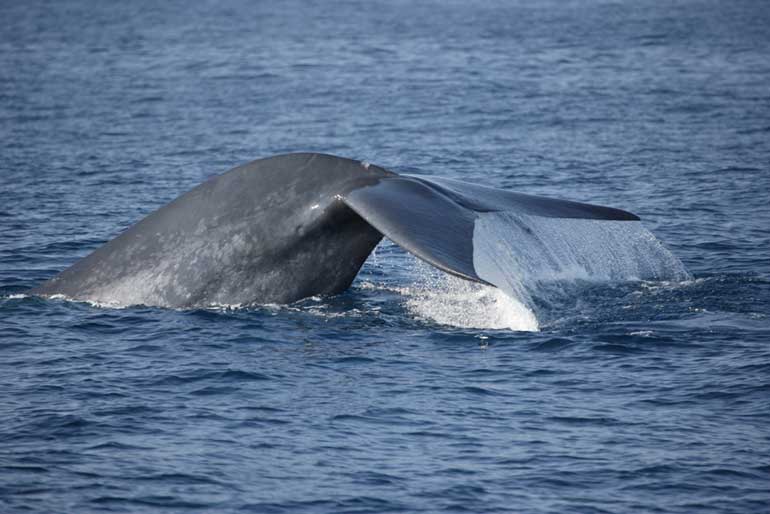
100 Blue Whale (c) Gehan de Silva Wijeyeratne YE0M3857 2008 04 04 Mirissa
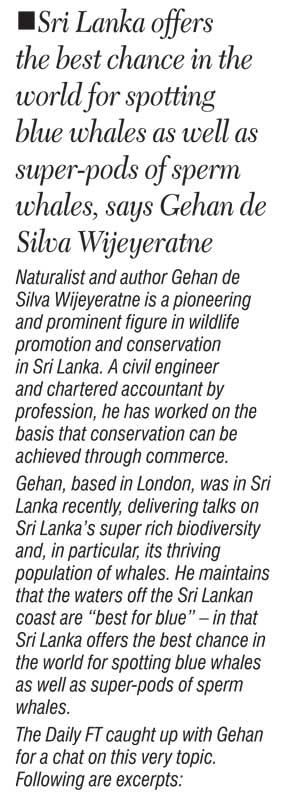 By Himal Kotelawala
By Himal Kotelawala
Q: Has Sri Lanka always been best for blue? Are there any records of whales being spotted in the seas off Sri Lanka, or of beached whales even, from pre-colonial days? If so/if not, when was the earliest recorded sighting?
A: In the 3rd century AD, the Greeks marked a ‘Cape of Whales’ on Sri Lanka’s south-east coast. In the 19th century, the Boston whalers hunted Sperm Whales off Sri Lanka. For several decades it was known that Blue Whales can see seen off Trincomalee. But it was only in May 2008 that Mirissa was branded as Best for Blue Whale with an intensive media campaign to brand it as a top location for Blue Whales.
Q: How many different species of whale/marine mammals can be sighted around Sri Lanka? Are there any new species that had not been spotted as frequently before? (Such as killer whales).
A: 26 species of cetaceans (whales, dolphins) and the dugong have been recorded in Sri Lankan waters, making a total of 27 species of marine mammals. It is only after the media blitz of May 2008 that commercial whale watching began in earnest and the larger whales began to be seen regularly. Even with species such as the Killer Whale or Orca, which is technically a dolphin, records before 2008 are very sparse. It was only in August 2012 that Sri Lanka was publicised as the best chance for seeing a super-pod of Sperm Whales on a commercial whale watch. Commercial whale watching has not added new species of marine mammals to the Sri Lankan list, but have added to what is known about them
Q: Is there a possibility of artificially introducing krill populations to Sri Lankan waters in order to prevent whales from migrating to international shipping lines? If not, are there any alternatives that you recommend?
A: Blue Whales feed on krill which bloom seasonally and cover such vast areas of the ocean that they can be seen from satellites that orbit the earth. Their exact location is driven by complex physical processes and their location can vary by tens of kilometres in any given year. At times the krill blooms will lie in the path of international shipping lanes. One way to reduce the risk of whales being killed by ship strikes is to have ‘go slow areas’ where it is known that whales seasonally feed on krill blooms.
Q: Whaling is not an issue in Sri Lanka, but there have been reports of dolphins being killed for human consumption. What are your thoughts on this?
A: There are reports that dolphins which drown in fishing nets are cut up at sea and sold as cheaper meat. Wrong doers are careful not to land ‘complete’ dead dolphins as they are more likely to be detected. It will require the police to be trained to recognise such illegal meat sales and to have a network of informants. There is no easy way to police this. In some countries they have introduced nets which reduce dolphins being trapped in nets.
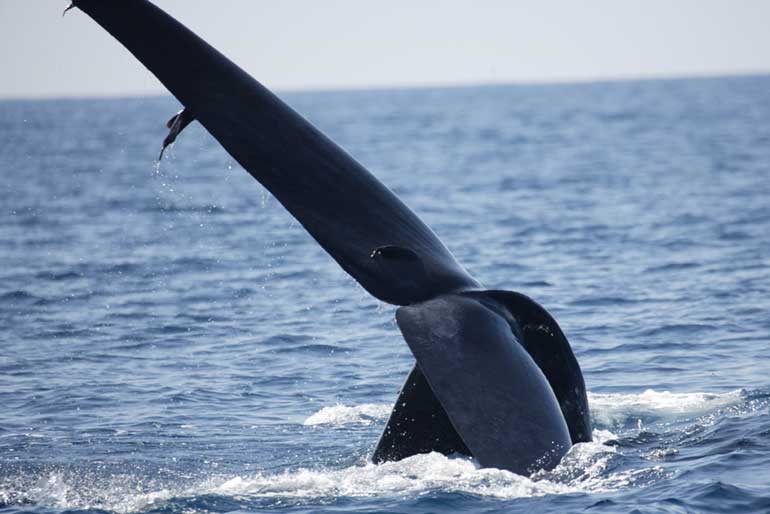 100 Blue Whale courtship (c) Gehan de Silva Wijeyeratne YE0M5132 2012 04 13 Mirissa
100 Blue Whale courtship (c) Gehan de Silva Wijeyeratne YE0M5132 2012 04 13 Mirissa
Q: Conventional wisdom says that whale watching would drive away whales from our seas. But you’ve noted in your research that the number of sightings have, in fact, been increasing over the years (since 2009). But, as you said, stats can lie. What are the real dangers presented by whale watching, irresponsible or otherwise?
A: An increased presence of whale watching boats means that there is a greater search effort. This could mean that the encounter rate for whales can stay static or even increase even if some whales are being disturbed by boats and moving away. So statistics need to be interpreted with care. I still find that when boats do not harass whales, the whales approach the boats and will continue to feed without moving way. On days when the numbers of whales are low or further away from shore, it is easy to think the explanation is that they have been chased away by whale watching boats. But it may actually be because they have moved onto where the concentrations of krill are. This is not to underestimate that whale watching boats can have an adverse impact if they do not conduct themselves responsibly. Any animal will feel threatened and move away if a convoy of boats or vehicles converge around it.
Q: How do you propose tour operators strike a balance between improved whale watching expeditions and keeping the whales safe?
A: There are a number of whale watching codes of conduct which prescribe common sense procedures. These should be adhered to make whale watching responsible in terms of the welfare of the whales as well as to provide a safe and good experience for clients.
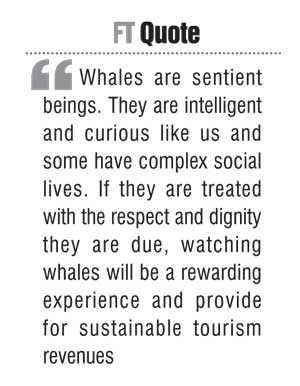
Q: If you could elaborate a bit on any environmental concerns?
A: Whale watching as with any tourism activity entails emissions and consumption that pollutes and leaves a carbon footprint. More specifically whale watching results in an increase in underwater sound which interferes with how whales communicate. We need to think in terms of the underwater acoustic landscape and minimise the disturbance. Some engine types and propeller types are better than others.
Q: Any existing government regulations and any that you personally recommend?
A: The Department of Wildlife Conservation has gazetted laws specifically in relation to whale watching. But in addition to this, in Mirissa, Kalpitiya and Trincomalee, environmentalists, state agencies and whale watching tour operators may need to consider moving towards fewer but larger boats for the mass tourism market. For example a boat that carries 30 people is less of a disturbance than 10 boats carrying three passengers each. A few small boats could still be licensed for those with specialist needs. On the down side, there could be resentment at the local level that small operators are being excluded. But it is not sustainable in the long term to have 30-60 boats combing a small area of ocean in search of whales. Fewer, larger, more responsible well regulated boats may be the future. But not enormous boats with propeller noise that is damaging to whales.
Q: What are your hopes for the future of human-whale relations?
A: Whales are sentient beings. They are intelligent and curious like us and some have complex social lives. If they are treated with the respect and dignity they are due, watching whales will be a rewarding experience and provide for sustainable tourism revenues.
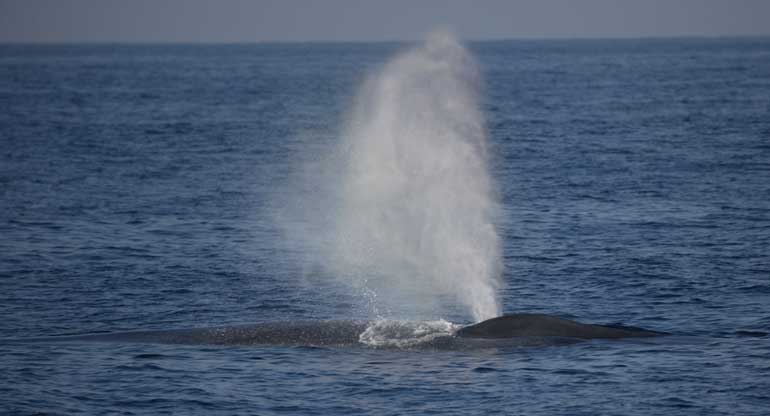 Blue Whale (c) Gehan de Silva Wijeyeratne YE0M3807 2008 04 04 Mirissa
Blue Whale (c) Gehan de Silva Wijeyeratne YE0M3807 2008 04 04 Mirissa
Discover Kapruka, the leading online shopping platform in Sri Lanka, where you can conveniently send Gifts and Flowers to your loved ones for any event including Valentine ’s Day. Explore a wide range of popular Shopping Categories on Kapruka, including Toys, Groceries, Electronics, Birthday Cakes, Fruits, Chocolates, Flower Bouquets, Clothing, Watches, Lingerie, Gift Sets and Jewellery. Also if you’re interested in selling with Kapruka, Partner Central by Kapruka is the best solution to start with. Moreover, through Kapruka Global Shop, you can also enjoy the convenience of purchasing products from renowned platforms like Amazon and eBay and have them delivered to Sri Lanka.
Discover Kapruka, the leading online shopping platform in Sri Lanka, where you can conveniently send Gifts and Flowers to your loved ones for any event including Valentine ’s Day. Explore a wide range of popular Shopping Categories on Kapruka, including Toys, Groceries, Electronics, Birthday Cakes, Fruits, Chocolates, Flower Bouquets, Clothing, Watches, Lingerie, Gift Sets and Jewellery. Also if you’re interested in selling with Kapruka, Partner Central by Kapruka is the best solution to start with. Moreover, through Kapruka Global Shop, you can also enjoy the convenience of purchasing products from renowned platforms like Amazon and eBay and have them delivered to Sri Lanka.